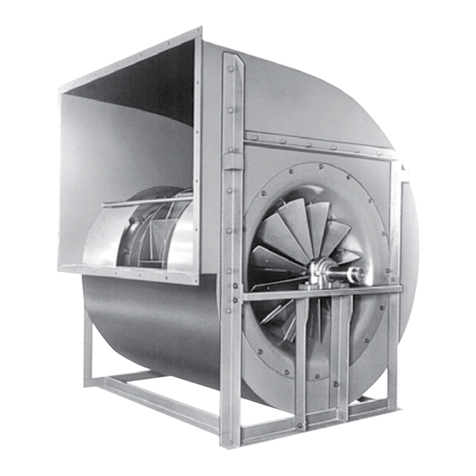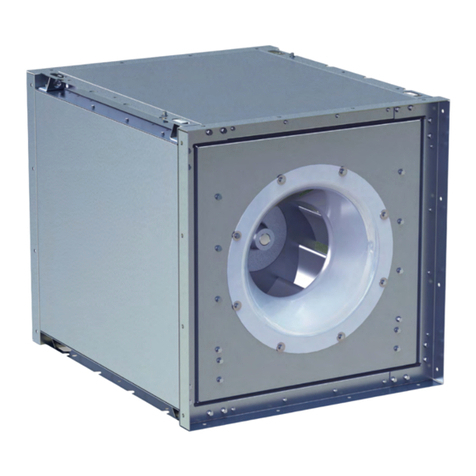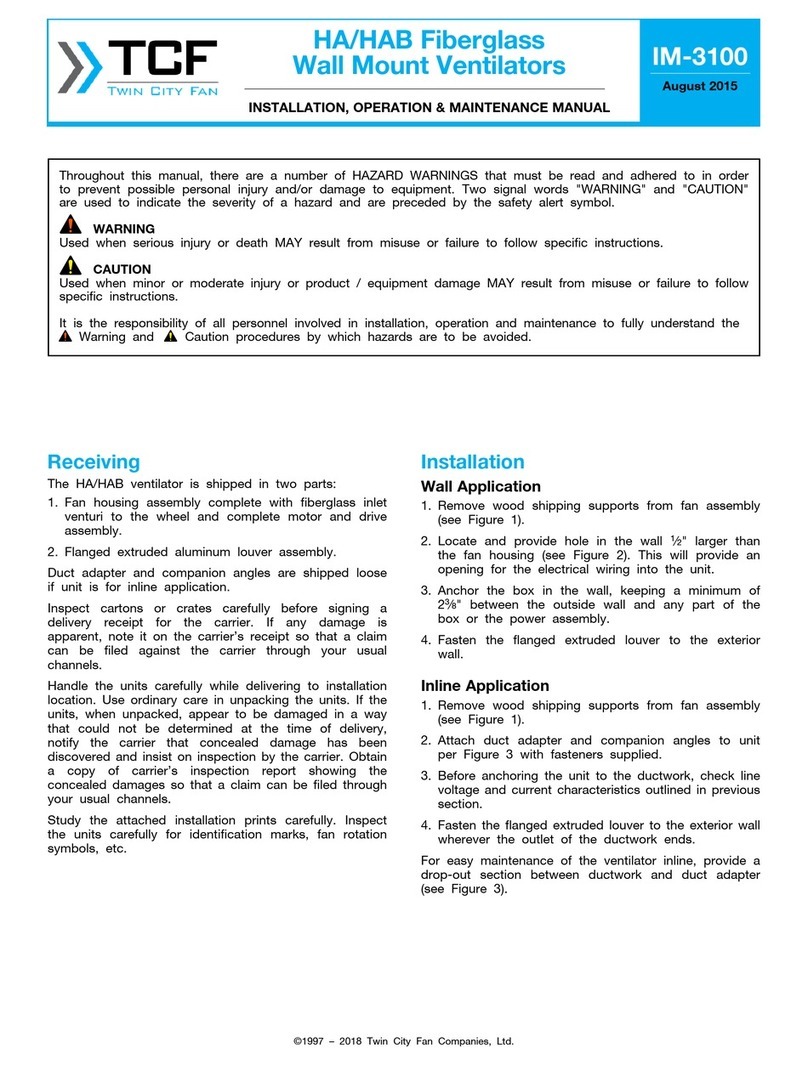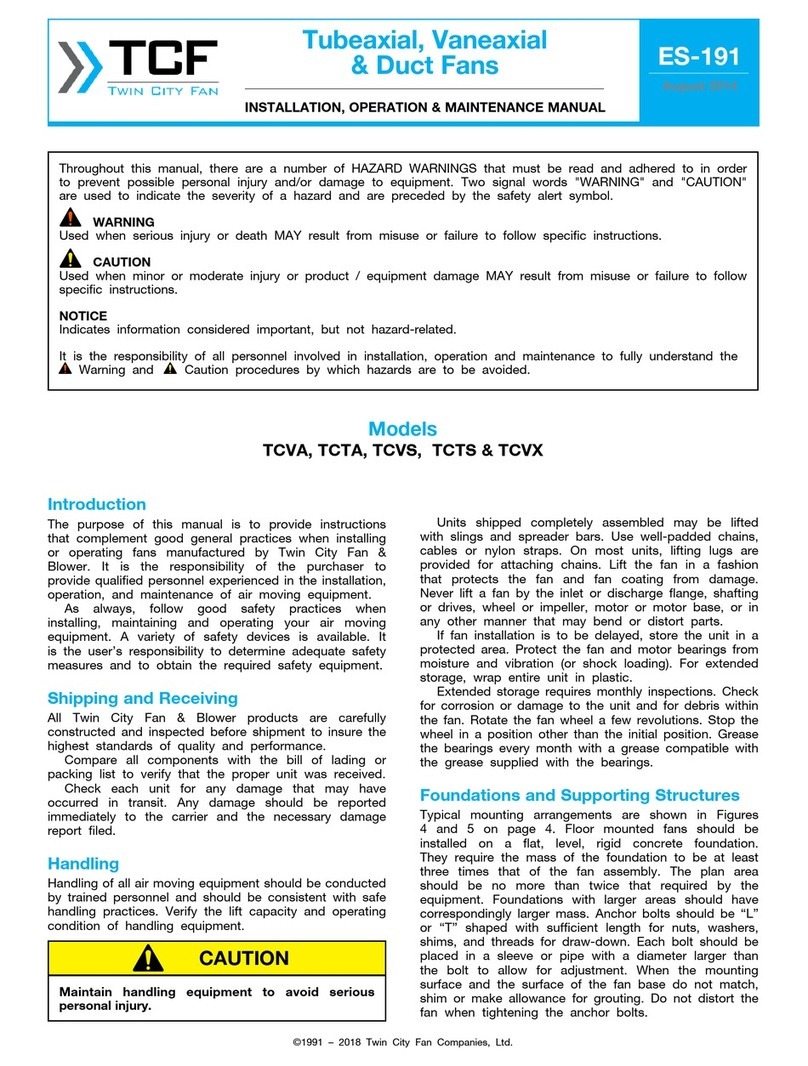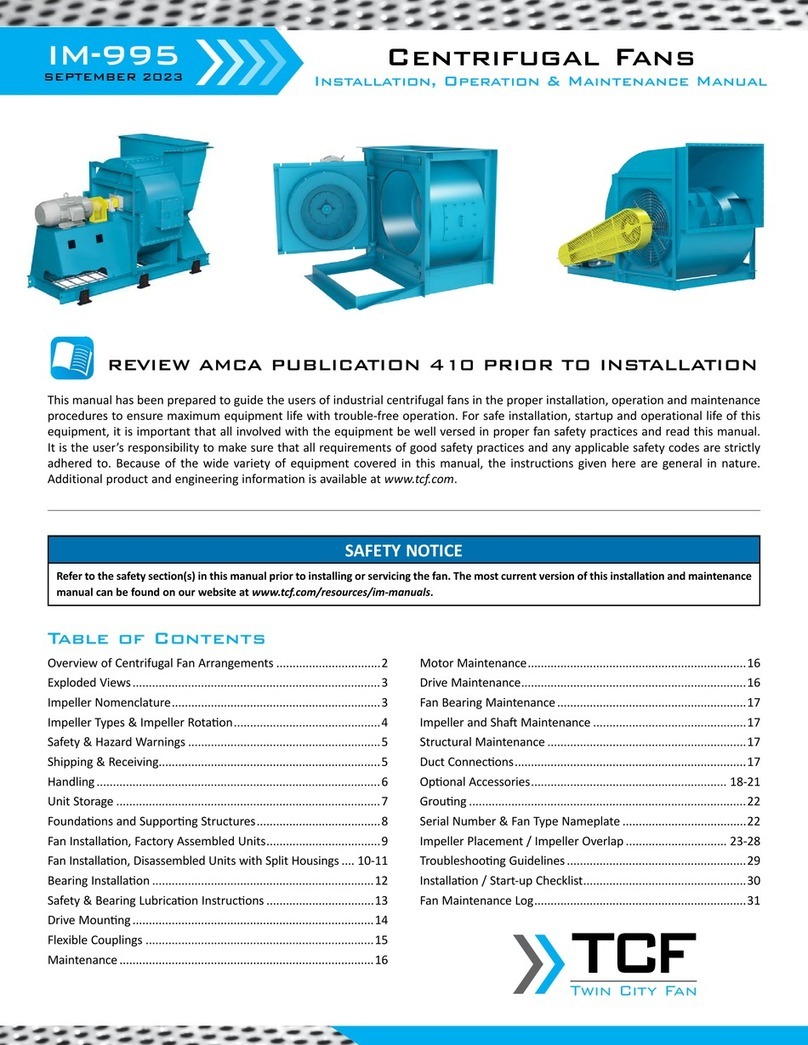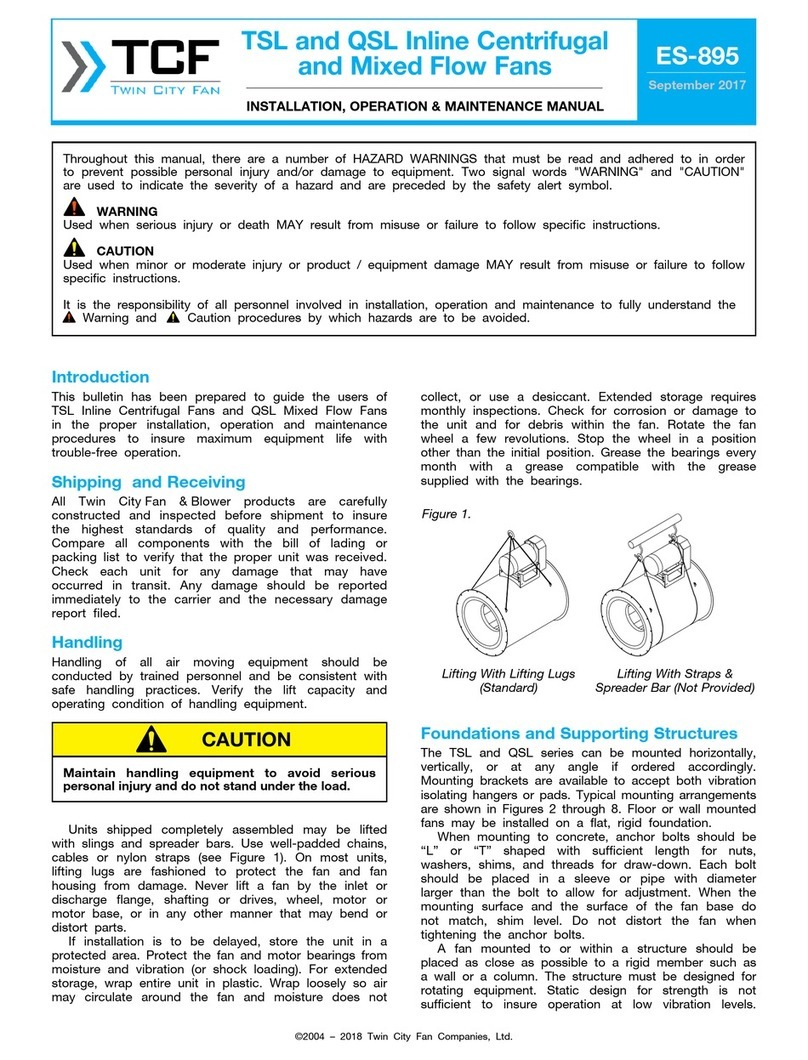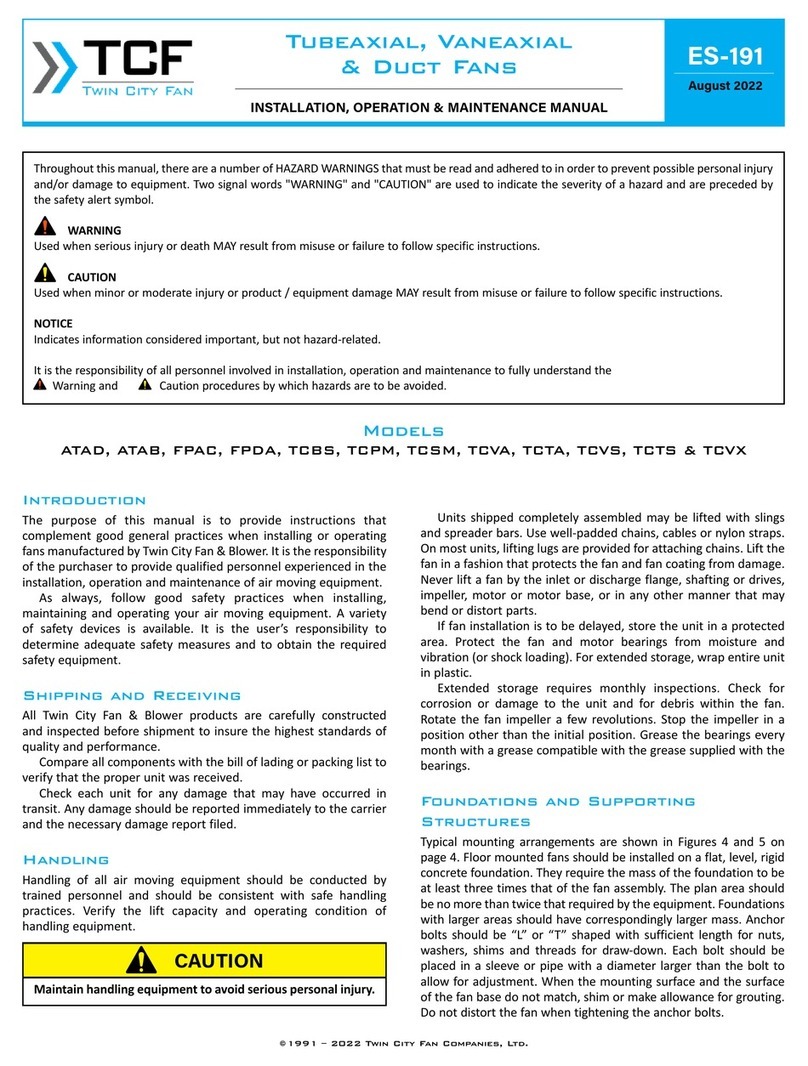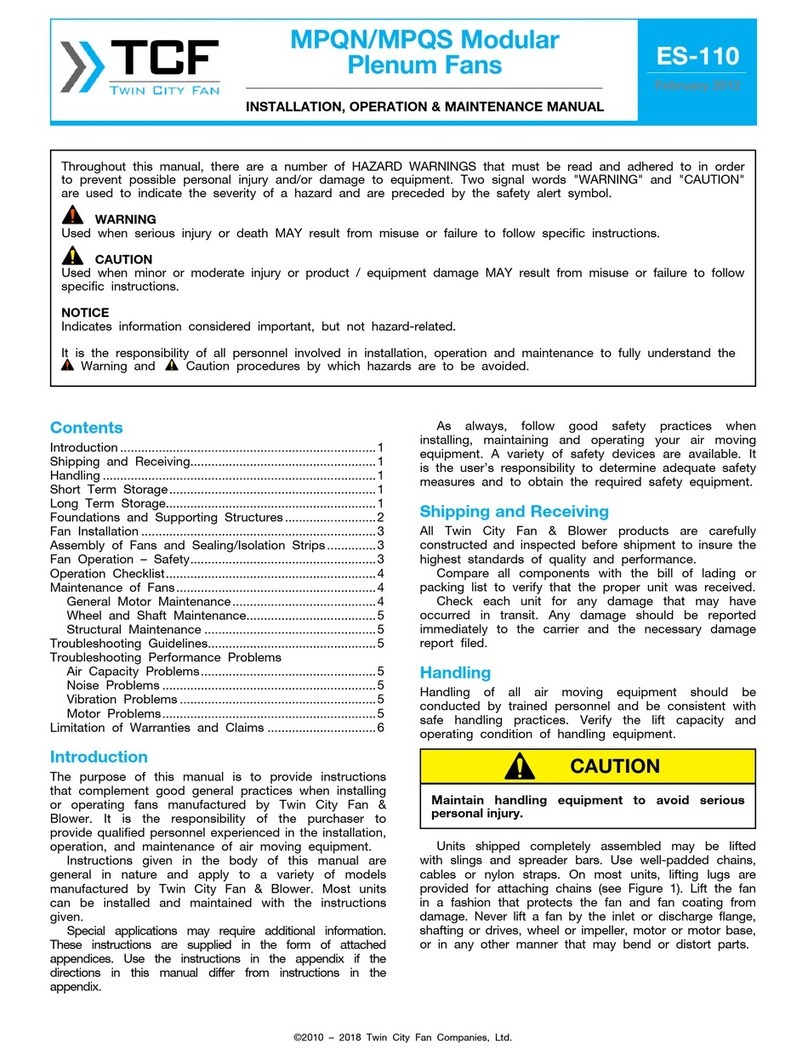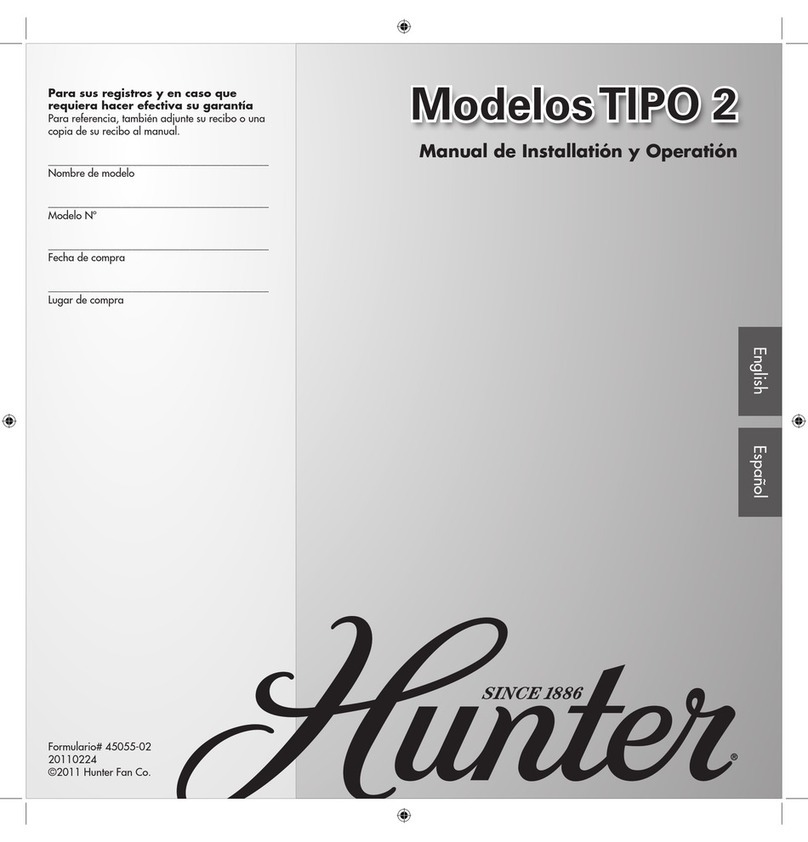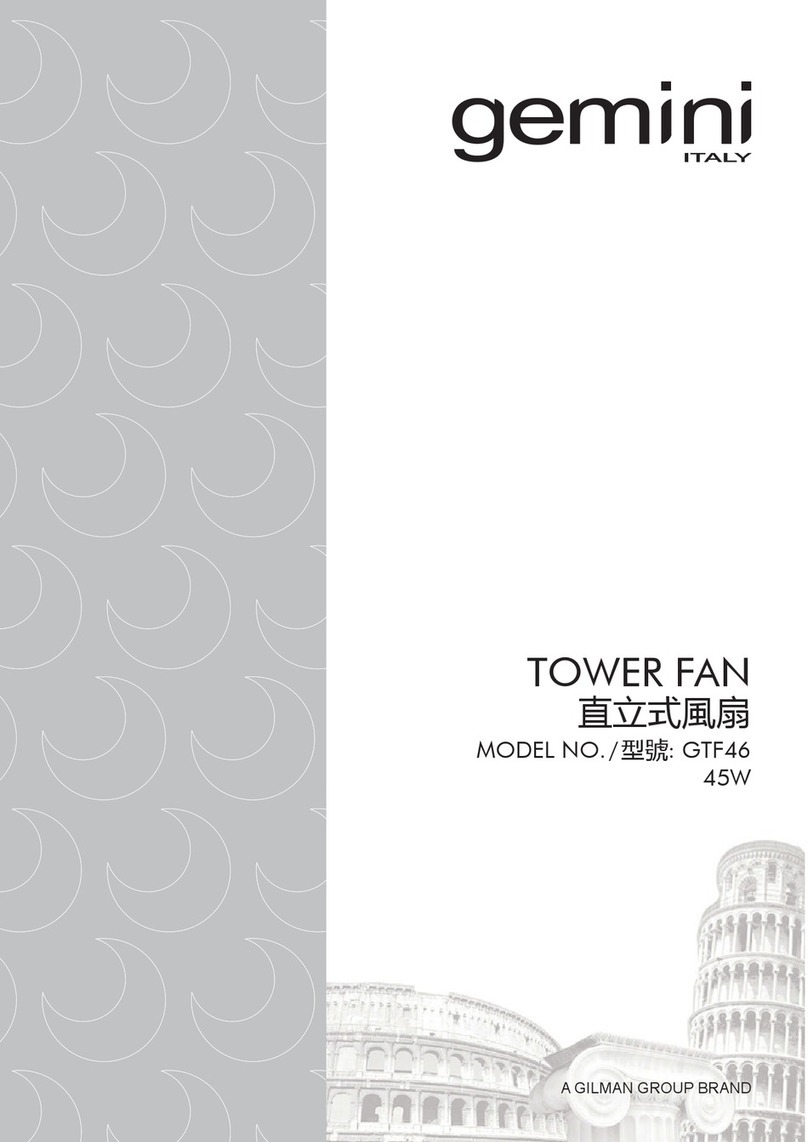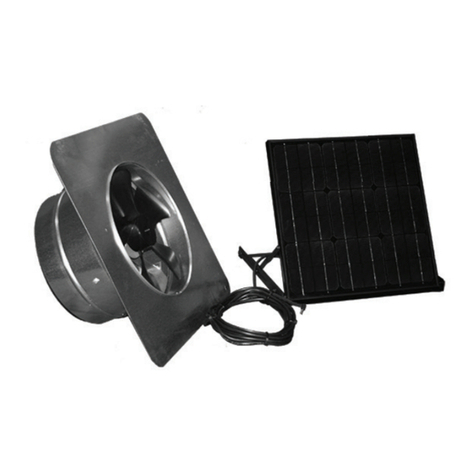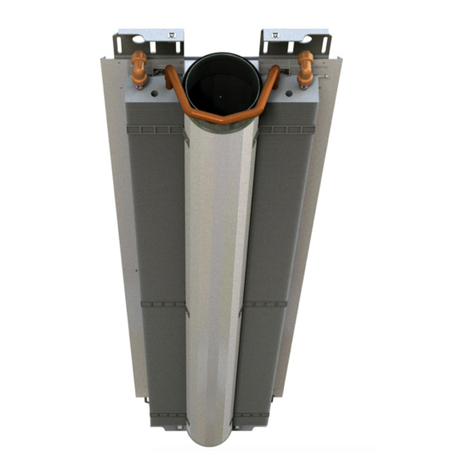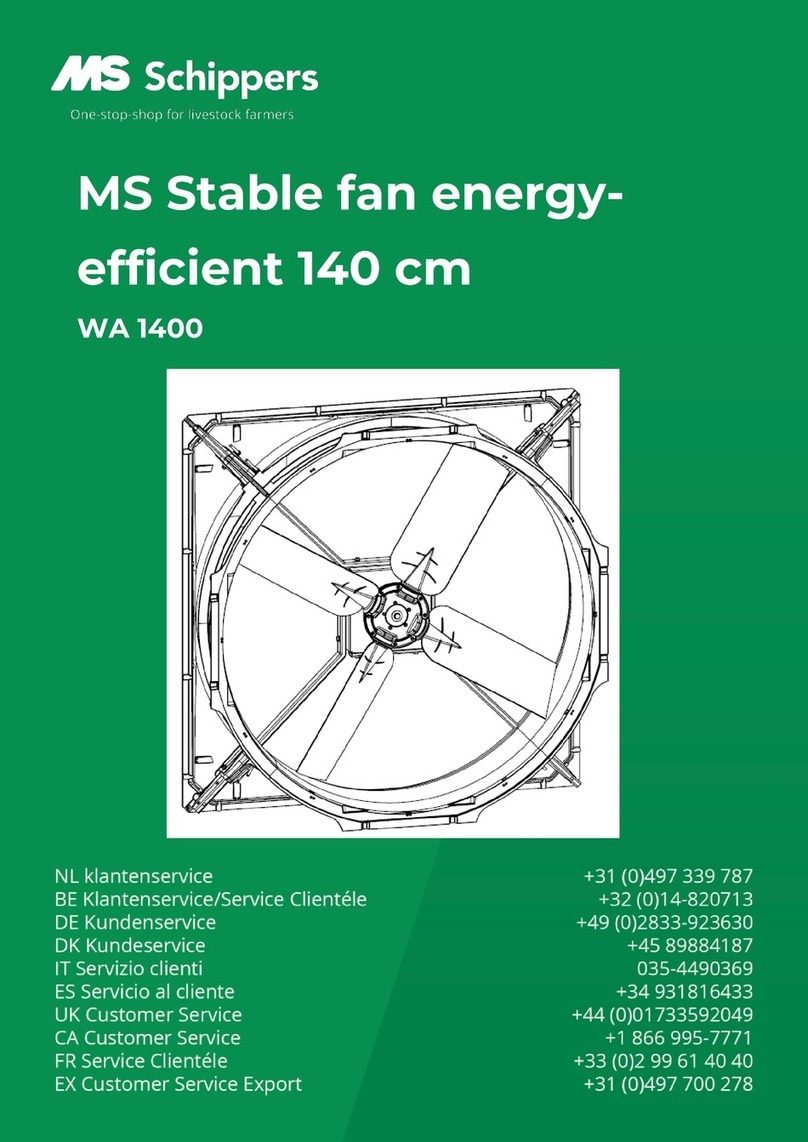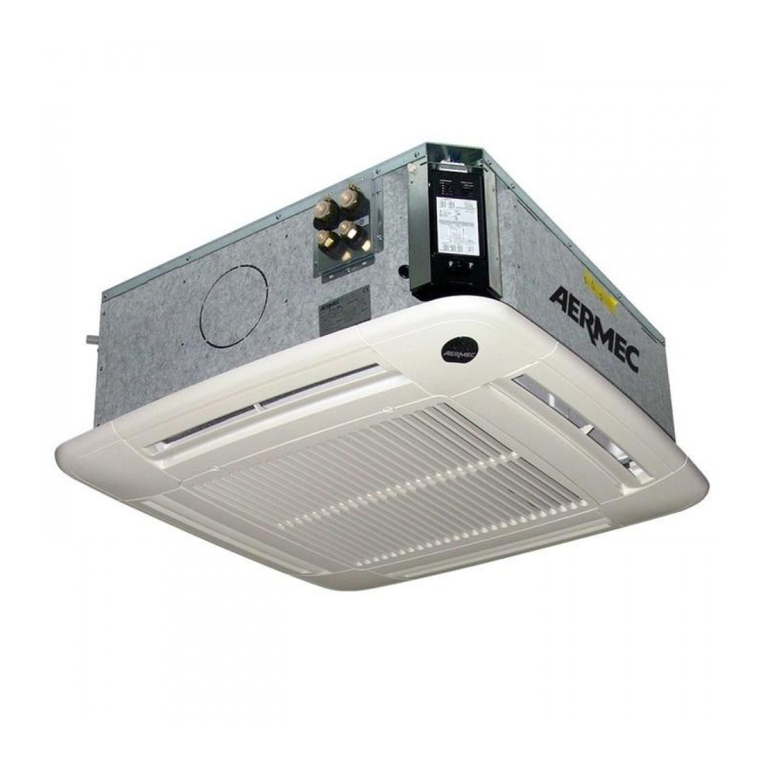TCF TCPE Instruction manual

©2009 – 2018 Twin City Fan Companies, Ltd.
Twin City Fan & Blower Catalogs 4800 and 4820 provide additional information on this equipment. These catalogs
can be found at www.tcf.com or by contacting your local Twin City Fan & Blower sales representative.
TCPE WPB WPD
IM-4800
July 2015
Propeller Wall Fans
INSTALLATION, OPERATION & MAINTENANCE MANUAL
Throughout this manual, there are a number of HAZARD WARNINGS that must be read and adhered to in order
to prevent possible personal injury and/or damage to equipment. Two signal words "WARNING" and "CAUTION"
are used to indicate the severity of a hazard and are preceded by the safety alert symbol.
WARNING
Used when serious injury or death MAY result from misuse or failure to follow specific instructions.
CAUTION
Used when minor or moderate injury or product / equipment damage MAY result from misuse or failure to follow
specific instructions.
NOTICE
Indicates information considered important, but not hazard-related.
SAFETY INSTRUCTIONS
Indicates specific safety-related instructions or procedures.
It is the responsibility of all personnel involved in installation, operation and maintenance to fully understand the
Warning and Caution procedures by which hazards are to be avoided.
Models
TCPE, WPB, WPD

2 Twin City IM-4800
Storage
If fans are stored for any length of time, they should
be stored in a clean, dry location to prevent rust and
corrosion. Outdoor storage is not recommended. When
outdoor storage is necessary, fans should be protected
from the elements as completely as possible. Cover the
fan inlet and outlet and keep motors dry and clean.
For extended storage (more than 3 months) motor shafts
and bearings should be rotated monthly. If stored longer
than 6 months, bearing grease in motor and fan should
be purged and replaced with compatible grease. Belts
should be rechecked for proper tension. Storage records
should be kept to assure proper maintenance. The
factory can advise warranty centers to provide motor
and bearing service if needed.
Seller warrants to the original purchaser that the
goods sold hereunder shall be free from defects in
workmanship and material under normal use and service
(except in those cases where the materials are supplied
by the buyer) for a period of one year from the date of
original installation or eighteen (18) months from the date
of shipment, whichever occurs first. The liability of seller
under this warranty is limited to replacing, repairing, or
issuing credit (at cost, F.O.B. factory and at seller’s
discretion) for any part or parts which are returned by
buyer during such period provided that:
a. Seller is notified in writing within ten (10) days
following discovery of such defects by buyer, or
within ten (10) days after such defects should
reasonably have been discovered, whichever is less;
b. The defective unit is returned to seller, transportation
charges prepaid by buyer;
c. Payment in full has been received by seller or said
products;
d. Seller’s examination of such unit shall disclose to its
satisfaction that such defects have not been caused
by misuse, neglect, improper installation, repair,
alteration, act of God, or accident.
No warranty made hereunder shall extend to any
seller product whose serial number is altered, effaced
or removed. Seller makes no warranty, express or
implied, with respect to motors, switches, controls,
or other components of seller’s product, where such
components are warranted separately by their respective
manufacturers. THIS WARRANTY IS EXPRESSLY IN LIEU
OF ALL OTHER WARRANTIES, EXPRESS OR IMPLIED,
WHETHER STATUTORY OR OTHERWISE, INCLUDING
ANY IMPLIED WARRANTY OF MERCHANTABILITY OR
FITNESS FOR A PARTICULAR PURPOSE. In no event
shall seller be liable to buyer for indirect, incidental
collateral, or consequential damages of any kind.
(BUYER’S FAILURE TO PAY THE FULL AMOUNT DUE
WITHIN SIXTY (60) DAYS OF DATE OF INVOICE SHALL
OPERATE TO RELEASE SELLER FROM ANY AND ALL
LIABILITY OR OBLIGATION ARISING PURSUANT TO
ANY WARRANTY, EXPRESS OR IMPLIED, WHETHER
STATUTORY OR OTHERWISE, INCLUDING ANY IMPLIED
WARRANTY OR MERCHANTABILITY OR FITNESS FOR
A PARTICULAR PURPOSE, MADE IN CONNECTION
WITH ANY CONTRACT FORMED HEREUNDER. BUYER
AGREES THAT SUCH FAILURE TO PAY SHALL
CONSTITUTE A VOLUNTARY WAIVER OF ANY AND ALL
SUCH WARRANTIES ARISING PURSUANT TO SUCH
CONTACT.)
Limitation of Warranties and Claims
Receiving, Unpacking & Inspection
When the equipment is received all items should be
carefully checked against the bill of lading to be sure all
crates and cartons have been received. Before accepting
delivery, carefully inspect each carton or crate for
visible shipping damage. If any damage is noticed, the
carrier should make the proper notation on the delivery
receipt acknowledging the damage. Make notations of
all damage on all copies of the bill of lading and have
all copies countersigned by the delivering carrier. The
carrier should also fill out a Carrier Inspection Report.
The factory Traffic Department should then be contacted.
File claim for damage with the carrier. Physical damage
to the unit after acceptance is not the responsibility of
Twin City Fan Companies, Ltd.
Unpack each carton or crate and verify that all required
parts and proper quantities of each item have been
received. Refer to drawings for part descriptions. Report
shortages or missing items to your local representative
to arrange for replacement parts.
Due to availability of carriers and truck space, it is not
possible to guarantee that all items will be shipped
together. Verification of shipments must be limited to
only those items on the bill of lading.
The installation of this equipment shall be in accordance
with the regulations of authorities having jurisdiction and
all applicable codes. This equipment is to be installed
by an experienced installation company and fully trained
personnel. The mechanical installation of the exhaust
ventilator consists of making final connections between
the unit and building services, duct connections.
Sheet metal parts, screws, clips and similar items
inherently have sharp edges, and it is necessary
that the installer and service personnel excercise
caution.
CAUTION
The unit nameplate must be checked to make sure
the voltage agrees with the power supply available.
NOTICE

Twin City IM-4800 3
Check, Test & Start Procedure
1. Check to verify that the propeller is free to rotate.
2. Verify that supply voltage on the line side of
disconnect agrees with voltage on fan data plate and
is within the 10% utilization voltage.
3. Apply power to unit and check rotation of propeller
with the directional arrow on the unit.
4. Electrical Input Check: Perform check of fan ampere
draw and verify that motor nameplate amps are not
exceeded. Take into account the service factor range
if motor is nameplated above a 1.0 service factor.
5. Fan RPM should be checked and verified with a
tachometer.
6. Units with Speed Control (TCPE): Verify that speed
controller gives desired operating range of RPM.
If minimum speed value is not desired, it may be
adjusted. See page 4.
Electrical Connection
1. Connect supply wiring to a disconnect switch. Check
the wiring diagrams on the motor for connections.
2. The motor is factory set at the voltage marked on
the fan nameplate. Check the line voltage with the
nameplate voltage and wiring diagrams.
3. The main power wiring should be sized for the
ampacity shown on the dataplate. Size wires in
accordance with the ampacity tables in Article 310
of the National Electrical Code. If long wires are
required, it may be necessary to increase wire size
to prevent excessive voltage drop. Wires should be
sized for a maximum of 3% voltage drop.
4. (Optional) Disconnect switches are not fused. The
power leads must be protected at the point of
distribution in accordance with the fan dataplate.
5. On fans without a thermal protector integral to the
motor (refer to unit or motor dataplate to determine
if protector is present) a separate overload device
is required. Refer to Sections 430-32 of the N.E.C.
for sizing.
6. All units must be electrically grounded in accordance
with local codes or, in the absence of local codes,
with the latest edition of the National Electrical
Code (ANSI/NFPA 70). A ground lug is provided as
standard in the unit terminal box. Size grounding
conductor in accordance with Table 250-95 of the
National Electrical Code. DO NOT use the ground
lug for connecting a neutral conductor.
7. Supply voltage to the power ventilator should not
vary by more than 10% of the value indicated
on the unit dataplate. Phase unbalance must not
exceed 2%.
Use copper conductors only.
Protect wiring from sharp edges. Leave some
slack in the line to prevent damage.
CAUTION
Failure of motor due to operation on improper
line voltage or with excessive phase unbalance
constitutes product abuse and may cause severe
damage to the unit’s electrical components.
WARNING
Electric shock hazard. Could cause severe injury or
death. Failure to bond the frame of this equipment
to the building electrical ground by use of the
grounding terminal provided or other acceptable
means may result in electrical shock. Disconnect
electric power before servicing equipment. Service
to be performed only by qualified personnel.
WARNING
BEFORE START-UP: Disconnect power to this unit
before servicing the unit.
SAFETY INSTRUCTIONS
The fan was balanced at the factory to be
within stringent vibration levels before shipment.
However, there are several things that may cause
vibration, such as rough handling in shipment and
installation, weak foundations and alignments.
NOTICE
Rotation is critical. If allowed to operate in the
wrong direction, the motor will overload and burn
out.
WARNING
Especially check three-phase units for rotation.
For three-phase, rotation can be changed by
interchanging any two of the three line leads. If
unit is checked on temporary wiring, it should
be rechecked when permanently installed. Motor
burn-out or tripped overload protection devices
are usually the result of wrong rotation.
WARNING

4 Twin City IM-4800
Figure 2. Low End Setpoint Adjustment
NOTE: 5 amp model shown. On 10 and 15 amp
models, adjustment is made through clearance
hole in heat sink.
SETPOINT
ADJUSTMENT
SCREW
Table 1. Speed Controller Size
MOTOR SPEED CONTROLLER
DESIGNATION / FLA
HP RPM VOLTAGE KBWC-15K
5 AMP
KBWC-110
10 AMP
KBWC-115
15 AMP
1/8 1650/1500/
1350 115V X
1/8 860 115V X
1/6 860 115V X
1/4 860 115V X
1/2 860 115V X
1/6 1140 115V X
1/4 1140 115V X
1/2 1140 115V X
1 1140 115V X
1/3 1725 115V X
1/2 1725 115V X
3/4 1725 115V X
Speed Control Installation
(Model TCPE - optional)
The controller is designed to start the motor at high
speed and will then slow down. This gives the motor
good starting characteristics.
Speed control is available using 115/60/1 open type
PSC or shaded pole motors.
Installation
Connect control in series with motor and line voltage
(115V only). Never connect across line. See Figure 1.
Minimum Speed Setpoint
All controls are factory set to 65V±3V output as standard
with an input voltage of 120V. If different minimum
speed is desired, the control may be adjusted by turning
minimum speed pot clockwise to decrease minimum
speed and counterclockwise to increase minimum speed.
Refer to Figure 2.
NOTE: For TCPE fans using Electronically Commutated
(EC) Motors, refer to IM-4055.
Figure 1. Connection Diagram, Speed Control
SPEED CONTROLLER
AC
LINE
(115V)
SWITCH TRI-AC
MOTOR
Table 2. Speed Controller RPM Range
NOTES:
1. Speed control available only with 115/60/1 open motors (thermally
protected).
2. Three-speed motor (multiple tap winding).
3. Speed control should not be connected to low speed tap on motor
because of starting characteristics.
4. Speed control connected to high speed tap on motor.
5. Speed control connected to medium speed tap on motor.
If minimum speed is readjusted, verify unit ampere
draw does not exceed motor nameplate amps. Do
not operate unit in range where amp draw exceeds
motor nameplate.
WARNING
These motors operate more efficiently in the ranges
set from the factory. Operating motor outside these
ranges (see Table 2) may cause motor to run hotter
and substantially shorten motor life.
CAUTION
Lowering the minimum speed setpoint may adversely
affect motor start-up characteristics.
NOTICE
Certain failure modes of solid-state controls such
as half-waving can cause high levels of DC, motor
overheating and motor burn-out. Therefore, a
thermal overload protection (integral with motor) is
required to limit the maximum motor temperature
under such a failure.
WARNING
Do not allow any sleeve bearing motor to operate
below 500 RPM. Operation below 500 RPM will
substantially shorten bearing life.
NOTICE
HP RPM MAX. RPM MIN. RPM
1/8 1650/1500/13502,3 1650413004
150059505
1/8
860 860 500
1/6
1/4
1/2
1/6
1140 1140 900
1/4
1/2
1
1/3
1725 1725 1200
1/2
3/4

Twin City IM-4800 5
1. The TCPE panel fan is an axial exhauster that can
be mounted either vertically or horizontally. Figure 3
depicts a typical wall installation.
2. A typical frame is usually roughed in so that the
inside square dimension is approximately 1⁄2" to 3⁄4"
more than what the fan panel measures. If using the
optional wall collar the frame should be 3⁄4" to 1"
more than what the fan panel measures.
3. Place the unit into the frame with the wiring hole A in
the position that is most suitable for wire to enter the
unit. Fasten the unit to the frame through the holes
provided using lag bolts. If the electrical wire will be
coming from within the wall that the TCPE is being
mounted to, run the wire through hole A by entering
it from the orifice side of the panel. This should be
done before the panel is fastened to the frame to
reduce the need of disassembly. If the wiring is not
done during the installation the motor and guard can
be removed from the panel fan without having to
actually remove the panel itself. See Figure 3. Make
sure a strain relief is attached to the wires after the
wire is pulled into position.
4. Connect the electrical wire to a disconnect switch
and then connect the wire to the motor (an optional
speed control may be installed in series with a 115V
ODP motor and disconnect switch). See Figure 1
on Page 4. The wiring diagram for the motor is on
a label attached to the motor. Main power wiring
should be sized for the amperage shown on the data
plate attached to the fan panel.
5. Disconnect switches (Optional) are not fused; there-
fore, the power leads must be protected at the point
of distribution in accordance with the unit data plate.
6. All TCPE motors are thermally protected. All units
must be electrically grounded in accordance with
local codes or in accordance with the NEC. A
grounding point is provided with all motors and will
be described on the wiring diagram that is attached
to the motor.
7. Supply voltage to the motor should not vary by more
than 10% of the value indicated on the unit data
plate. Phase unbalance must not exceed 2%.
8. Make sure unit is properly sealed around the frame
edges so that the outside elements cannot enter the
building.
PANEL
MOUNTING
FRAMING
BOLTS TO
REMOVE FAN
WIRING
HOLE ‘A’
ROTATION
AIRFLOW
Figure 3. Typical Installation
Figure 4. Fan Assembly Without a TCPE Wall Collar
M" (Min).
BACK OF
FAN TO
DAMPER DAMPER
WEATHERHOOD
(EXTENDED FLANGE)
FAN
FIELD
FABRICATED
WALL COLLAR
Wall Opening Requirements
Wall opening size and the distance between propeller
and damper are two important dimensions for fan
installation. Fans mounted in or to the wall require a
different wall opening size than those mounted in collars.
Propeller-to-damper distance (M) is important to reduce
turbulence at the damper, which may lead to premature
damper failure, and to prevent the propeller blades from
hitting the actuator on motorized damper units.
TCPE
SIZE
PANEL
SQ.
WALL
OPENING
DAMPER
SIZE 'M' (MIN.)
8 13.25 13.75 10 x 10
14.010 15.25 15.75 12 x 12
12 18.25 18.75 15 x 15
14 21.25 21.75 18 x 18
14.016 23.25 23.75 20 x 20
18 25.25 25.75 22 x 22
20 27.25 27.75 24 x 24 14.0
24 30.25 30.75 27 x 27
Panel Installation (without collar) — TCPE
Use copper conductors only.
Protect all wires from sharp edges. Do not route
wire through wiring hole without a strain relief to
protect it.
CAUTION
Failure of the unit due to improper line voltage or
excessive phase unbalance constitutes product
abuse. Severe damage to the unit’s electrical
components may occur.
WARNING

6 Twin City IM-4800
FAN
AIR
FLOW BACKDRAFT
DAMPER
SPACER
(BY OTHERS)
MIN
To achieve the minimum 'M' dimension,
this installation requires a spacer (by others)
between the fan and the wall.
If the wall is equal to or greater than the
minimum 'M' dimension, the fan can be
mounted directly to the wall.
Wall Opening Requirements
Wall opening size and the distance between propeller and damper are two important dimensions for fan installation.
Fans mounted to the wall require a different wall opening size than those mounted in collars or wall boxes. Propeller-
to-damper distance (M) is important to reduce turbulence at the damper which may lead to premature failure, and to
prevent the propeller blades from hitting the actuator on motorized damper units. Use general installation procedure
from page 5.
PROP
SIZE
PANEL SQ. WALL OPENING (MIN.) DAMPER SIZE 'M'
(MIN.)
SURFACE MOUNT RECESS (IN WALL)
WPB WPD WPB WPD WPB WPD WPB WPD
14 -- 17.00 -- 14.50 -- 17.50 -- 14 x 14
16.0016 -- 20.00 -- 17.50 -- 20.50 -- 17 x 17
18 -- 22.00 -- 19.50 -- 22.50 -- 19 x 19
21 25.00 25.00 22.50 22.50 25.50 25.50 22 x 22 22 x 22
16.0024 28.00 28.00 25.50 25.50 28.50 28.50 25 x 25 25 x 25
30 36.00 36.00 33.50 33.50 36.50 36.50 33 x 33 33 x 33
36 42.00 42.00 39.50 39.50 42.50 42.50 39 x 39 39 x 39
16.0042 48.00 48.00 45.50 45.50 48.50 48.50 45 x 45 45 x 45
48 54.00 54.00 51.50 51.50 54.50 54.50 51 x 51 51 x 51
54 60.00 -- 57.50 -- 60.50 -- 57 x 57 -- 19.00
60 66.00 -- 63.50 -- 66.50 -- 63 x 63 --
Panel Installation (without accessories) — WPB & WPD

Twin City IM-4800 7
WALL COLLAR WITH ACCESSORIES — TCPE
Mounting Screw
Fan
Wall Collar
Backdraft Damper
Weatherhood
or
Damper
Guard
ON
OFF
Variable
Speed Control
(Optional)
Disconnect Switch
(Optional)
OFF
ON
Removable Screen
Panel Fan
OSHA Motor
Side Guard
Backdraft Damper
Weatherhood
Damper Guard
Bird Screen
Wall Collar
Disconnect
Switch
OFF
ON
Removable Screen
Panel Fan
Wall Box
Backdraft Damper
Weatherhood
Bird Screen
Damper Guard
Disconnect
Switch
WALL COLLAR WITH ACCESSORIES — WPB, WPD
WALL BOX WITH ACCESSORIES — WPB, WPD

8 Twin City IM-4800
Mounting Arrangements — With Wall Collar or Wall Box
Flush with Outside Wall
WEATHERHOOD
WITH SCREEN
BACKDRAFT DAMPER
M
O
UNTIN
G
FLAN
G
E
REMOVABLE
GUARD SCREEN
AIR
FLOW
FAN
SUPPORTS
(BY OTHERS)
WEATHERHOOD
WITH SCREEN
BACKDRAFT DAMPER
SUPPORTS
(BY OTHERS)
M
O
UNTIN
G
FLAN
G
E
REMOVABLE
GUARD SCREEN
AIR
FLOW
FAN
Middle of Wall
WEATHERHOOD
WITH SCREEN
BACKDRAFT DAMPER
M
O
UNTIN
G
FLAN
G
E
REMOVABLE
GUARD SCREEN
AIR
FLOW
FAN
SUPPORTS
(BY OTHERS)
Flush with Interior Wall
WEATHERHOOD
WITH SCREEN
BACKDRAFT DAMPER
M
O
UNTIN
G
FLAN
G
E
REMOVABLE
GUARD SCREEN
AIR
FLOW
FAN
SUPPORTS
(BY OTHERS)
WEATHERHOOD
WITH SCREEN
BACKDRAFT DAMPER
M
O
UNTIN
G
FLAN
G
E
SUPPORTS
(BY OTHERS)
FAN
REMOVABLE
GUARD SCREEN
AIR
FLOW
WEATHERHOOD
WITH SCREEN
BACKDRAFT DAMPER
M
O
UNTIN
G
FLAN
G
E
REMOVABLE
GUARD SCREEN
AIR
FLOW
SUPPORTS
(BY OTHERS)
FAN
Exhaust
Exhaust
Exhaust Supply
Supply
Supply
INSIDE
INSIDE OUTSIDE OUTSIDE
INSIDE
INSIDE OUTSIDE OUTSIDE
INSIDE
INSIDE OUTSIDE OUTSIDE

Twin City IM-4800 9
Wall Collar, Wall Box Housings
The wall collar and wall box are intended to give the panel fan an easy way to adapt other accessories for a
completed unit. They are set up to accept a panel fan, damper, and weatherhood or a damper guard screen. All
holes are pre drilled for the fan and accessories to help make the installation easy.
Wall Collar Installation
1. If the collar is ordered as a field assembly, assemble it first by following the directions provided with the kit.
2. When roughing in the frame make the inside dimension 1⁄2" to 3⁄4" larger than the outside dimension of the collar.
This will give the collar enough clearance so that it will install easily.
3. Predrill holes into the collar wherever it is decided that it can be fastened to the roughed-in frame. The wall collar
can be fastened to a roughed-in frame with lag screws through holes that need to be drilled into the collar. It is
recommended that two lag screws per collar side be used to fasten it to the frame and that the bent edge of
the collar is flush with the outside wall.
4. If power is coming into the unit from within the wall a 3⁄4" to 1" hole may also have to be drilled for the power
wire to enter the collar. Be sure the metal edges of the hole are protected so the wire will not get cut.
5. If a damper, weatherhood or damper guard screen are being used, they can be fastened to the collar before the
collar is fastened to the frame.
6. Make sure the edges around the collar and frame are sealed after it is installed.
The wall box is installed in the same way.
TCPE
SIZE
COLLAR
SQ.
WALL
OPENING
8 13.50 14.25
10 15.50 16.25
12 18.50 19.25
14 21.50 22.25
16 23.50 24.25
18 25.50 26.25
20 27.50 28.25
24 30.50 31.25
WPB/WPD
SIZE
COLLAR/WALL
BOX SQ.
WALL
OPENING
WPB WPD WPB WPD
14 -- 17.25 -- 18.00
16 -- 20.25 -- 21.00
18 -- 22.25 -- 23.00
21 25.25 25.25 26.00 26.00
24 28.25 28.25 29.00 29.00
30 36.25 36.25 37.00 37.00
36 42.25 42.25 43.00 43.00
42 48.25 48.25 49.00 49.00
48 54.25 54.25 55.00 55.00
54 60.25 -- 61.00 --
60 66.25 -- 67.00 --
Weatherhood and Damper Guard Screen
The weatherhood and damper guard screen are both items designed to help protect the damper from damage and
keep birds and other things from entering the building. The weatherhood will help deflect the outside elements from
entering into the building through the fan. It also helps protect the damper from being inappropriately operated by
the wind.
Weatherhood/Damper Guard Screen Installation
1. If mounting the damper guard screen or weatherhood onto a wall collar place it over the damper and use the
self-tapping screws provided with the collar to fasten it through the pre drilled holes in the collar’s bent edge.
2. Make sure any undesired gaps are sealed to keep the elements from leaking into the building.

10 Twin City IM-4800
Maintenance
Installation and maintenance are to be performed only by
qualified personnel who are familiar with local codes and
regulations and experienced with this type of equipment.
Preventive maintenance is the best way to avoid
unnecessary expense and inconvenience. Start-up and
routine maintenance should cover the following items:
a. Tighten all setscrews, bolts and wire connections.
b. Check belt tension and sheaves for wear.
c. Lubricate fan bearings (see Tables 3 and 4).
d. Cleaning of unit, propeller and damper (if present).
All motors containing ball bearings are permanently
lubricated from the factory. No additional maintenance
is required.
1. Before performing any maintenance on the fan, be
sure power is turned off and locked in the OFF
position at the service entrance.
2. Ventilators should be carefully checked at least once
a year. For critical or rugged applications, a routine
check every two or three months is suggested.
3. All motors supplied with Twin City Fan & Blower
ventilators carry a one-year limited warranty from
date of shipment. For repairs within the warranty
period, the motor must be taken to the motor
manufacturer’s authorized service dealer. Contact
your representative for additional warranty details.
4. A periodic motor check should consist of spinning
the motor shaft with the power off to be sure the
motor turns freely and the bearings run smoothly.
The belt on belt driven units should be removed
from the motor sheave.
5. When removing or installing a belt, do not force the
belt over the sheave. Loosen the motor mount so
that the belt can be easily slipped over the sheave.
6. The belt on belt driven units should be removed and
carefully checked for glazing, cracks, ply separation
or irregular wear. A small irregularity in the contact
surface of the belt will result in noisy operation. If
any of these defects are apparent, the belt should
be replaced. Check the sheaves also for chipping,
dents or rough surfaces which could damage the
belt.
7. The correct belt tension is important. Too tight of
a belt will result in excess bearing pressure on the
motor bearings and shaft pillow blocks and may also
overload the motor. Too loose of a belt will result in
slippage which will quickly “burn” out belts. A belt
should feel “live” when thumped, approximately 1⁄4"
belt deflection (3 to 5 lb.) when subject to finger
pressure at midpoint between sheaves.
8. The belt alignment should also be checked to
be sure the belt is running perpendicularly to the
rotating shafts. Fan and motor shafts must be
parallel. Improper alignment will result in excessive
belt wear.
9. Check sheave setscrews to ensure tightness. Proper
keys must be in keyways.
10. For blade angle adjustments on Type 'E' Propellers
(Level 3) refer to Engineering Supplement ES-404.
11. If unit is to be left idle for an extended period, it
is recommended that belts be removed and stored
in a cool, dry place to avoid premature belt failure.
12. The standard pillow block bearings on belt driven
ventilators are factory lubricated and are provided
with external grease fittings. Annual lubrication is
recommended, or more frequently if needed (see Table 3).
It is recommended to add fresh grease at start-up,
but do not over-grease. Use only 1 or 2 shots of
a recommended lubricant with a hand gun in most
cases (see Table 4). Maximum hand gun rating 40
P.S.I. Rotate bearings during lubrication where good
safety practice permits.
The most frequent causes of bearing failure are not
greasing often enough, using an excessive quantity
of grease or using incompatible greases. Excessive
vibration, especially if the bearing is not rotating, will
also cause bearings to fail. Bearings must also be
protected from water and moisture to avoid internal
corrosion.
13. During the first few months of operation it is
recommended that the bearing setscrews be
checked periodically to ensure that they are tight.
14. The rotating propeller requires particular attention
since materials in the air being handled can build
up on the blades to cause destructive vibration or
weaken the structure of the propeller by corroding
and/or eroding the blade metal. Regular inspection
and corrective action at intervals determined by the
severity of each application are essential to good
service life and safety.
Sharp edges and screws are a potential injury
hazard. Avoid them.
CAUTION
Hazardous moving parts. Unit may contain protected
fan motor which may start automatically and cause
injury. Allow time for reset. Disconnect power before
servicing.
WARNING
Greases of different soap bases (lithium,
sodium, etc.) may not be compatible when
mixed. Prevent such intermixing by completely
purging the bearing of old greases.
CAUTION

Twin City IM-4800 11
Fan bearings on belt driven fans should not need to be
replaced for many years if the previous recommendations
are strictly adhered to. However, use the following
procedure when bearing replacement is necessary.
1. Gain access to the fan bearings. Remove the
bearing cover, if any.
2. Loosen the belts by shifting the motor.
3. Remove the propeller and disconnect the remote
lubrication tubes (if applicable).
4. Measure the location of the bearing to the propeller
end of the shaft and the bearing spacing.
5. Remove the shaft and bearing assembly. Note the
position of the bearings’ shims (if applicable).
6. Loosen all bearing/shaft setscrews or other locking
devices.
7. Remove bearings (may need to be pressed off the
shaft).
8. Polish the shaft with fine emery paper (240 grit or
finer) and file the setscrew dimples left on the shaft
flat.
Bearing Replacement
Motors
9. Install new bearings on the shaft, making sure that
the collars are together (i.e. facing each other on the
shaft). Lightly seat one setscrew or eccentric locking
collar on each bearing to hold in the approximate
marked position.
10. Mount the shaft/bearing assembly in the fan with
bolts. Do not tighten yet. Just snug up. Loosen the
setscrew.
11. Center the shaft in the housing (both ends) as
closely as possible. (The fan propeller may need to
be temporarily installed to get its clearances equal.)
12. Tighten the bearing mounting bolts.
13. Reinstall the lube tubes (if applicable).
14. Install propeller and belts and adjust the motor to
get proper belt tension. Also, make sure that the
sheaves are properly aligned.
15. If a new shaft is supplied, ignore items 6 thru 8.
Twin City Fan & Blower recommends periodic checks
of voltage, frequency and current of a motor while
in operation. Such checks assure the correctness of
frequency and voltage applied to the motor, and yield
an indication of the fan load. Comparison of this data
with previous data will give an indication of the fan
performance. Any serious deviations could indicate a
potential motor failure.
All motors have pre lubricated sealed bearings and are
lubricated for the life of the motor.
1. All motors carry a one-year limited warranty from date
of shipment. For repairs within the warranty period,
the motor must be taken to the motor manufacturer’s
authorized service dealer. Contact your representative
for additional warranty details.
2. A periodic motor check should consist of spinning
the motor shaft with the power off to be sure the
motor turns freely and the bearings run smoothly. The
belt on belt driven units should be removed from the
motor pulley.
Repair or replacement of motors is normally performed
by a repair station authorized by the manufacturer.
Contact your representative or the factory for locations
nearest you. DO NOT ship motor to the factory without
specific authorization forms.
Table 3. Suggested Fan Bearing Greasing Intervals Table 4. Grease Manufacturers
MANUFACTURER GREASE (NLGI #2)
Shell Gadus S2 V100 2
Exxon/Mobil Ronex MP
INTERVAL
(MONTHS) TYPE OF SERVICE
12 to 18 Infrequent operation or light duty in
clean atmosphere
6 to 12 8 to 16 hrs./day in clean, relatively dry
atmosphere
3 to 6 12 to 24 hrs./day, heavy duty, or if
moisture is present
1 to 3
Heavy duty in dirty, dusty locations; high
ambient temperatures; moisture laden
atmosphere; vibration

12 Twin City IM-4800
Figure 5. Eliminate Slack Figure 6. Belt Deflection
Figure 7. Alignment Figure 8. Belts
Figure 9. 2-Groove Sheaves
Deflection
Deflection = Belt Span
64
Belt Span
Slack belts wear excessively, cause slippage
and deliver less power. For longest belt life,
always provide proper tension
Mount belts straight. Shafts must be parallel
and sheaves in alignment to prevent unnec-
essary belt wear.
Two-groove variable pitch
sheaves must be opened the
same number of turns on
both sides; otherwise, slip-
page occurs, wearing belts
rapidly,
Do not force belt. Forcing the belt will
break the cords and cause belt failure.
V-Belts
V-belts on these belt driven fans are oil, heat, and static
resistant type and oversized for continuous duty. With
proper installation and maintenance, years of operating
efficiency can be added to the lifespan of the V-belt
drive.
The condition of V-belts and the amount of belt tension
should be checked prior to start-up (see Figure 5).
When it becomes necessary to adjust belt tension,
do not over-tension as bearing damage will occur.
Recommended belt tension should permit 1⁄64" deflection
per inch of span of the belt at the center of the belt
span. To find this point, measure halfway between the
pulley centerlines as shown in Figure 6. Extreme care
must be exercised when adjusting V-belts as not to mis-
align the pulleys. Any misalignment will cause a sharp
reduction in belt life and will also produce squeaky,
annoying noises (see Figure 7). On units equipped with 2
groove pulleys, adjustments must be made so that there
is equal tension on all belts (see Figure 9).
1. Where tensioning rods are not available, adjustment is
more easily obtained by loosening and adjusting one
side of the motor bracket at a time.
2. Always loosen tension adjustment enough to place
belts on sheaves without running belts over the
edge of either sheave. A new belt may be seriously
damaged internally by careless handling (see Figure 8).
3. Fan speed can be increased by closing the adjustable
motor pulley, or decreased by opening it. Two
and three groove adjustable pitch pulleys must be
adjusted an equal number of turns. (See Figure 9).
Always check load on motor when increasing fan
speed.
CORRECT
INCORRECT
When removing or installing belts, never force
belts over pulleys without loosening motor first to
relieve belt tension.
WARNING

Twin City IM-4800 13
Fan Troubleshooting Chart
PROBLEM POSSIBLE CAUSES
FAN DOES NOT OPERATE 1. Wrong voltage.
2. Electricity turned off or not wired properly.
3. Tripped overload protector.
4. Blown fuses.
5. Loose pulleys.
6. Broken belts.
TOO LITTLE AIR 1. Propeller rotating in wrong direction.
2. Fan speed lower than design.
3. System is more restrictive (more static pressure) than expected.
4. Restricted fan inlet or outlet.
5. Inlet or outlet screens clogged.
6. Filters, if applicable, are dirty or clogged.
TOO MUCH AIR 1. Fan speed higher than design.
2. System is less restrictive (less static pressure) than expected.
3. Filters, if applicable, not in place.
EXCESSIVE HORSEPOWER 1. Propeller rotating in wrong direction.
2. Propeller rubbing on inlet venturi.
3. Fan speed higher than design.
4. Worn fan bearings.
EXCESSIVE NOISE 1. Propeller or sheaves loose.
2. Bearing or drive misalignment.
3. Accumulation of material on propeller.
4. Worn or corroded propeller.
5. Propeller out of balance.
6. Propeller hitting housing.
7. Bent shaft.
8. Bearings need lubrication.
9. Loose bearing bolts.
10. Loose or worn bearings.
11. Mismatched belts.
12. Belts too loose or too tight.
13. Belts oily or dirty.
14. Belts worn.
15. Loose fan mounting bolts.
16. Rattle of components in high velocity airstream.
17. Electrical noise.
18. Noise from high velocity air system.
19. Vibrating parts not isolated from building.
20. Vibrating ductwork.
EXCESSIVE VIBRATION 1. Propeller or sheaves loose on shaft.
2. Propeller out of balance.
3. Excessive buildup of dirt/dust on propeller.
4. Belts too loose or too tight.
5. Mismatched belts.
6. Bent shaft.
7. Bearing or drive misalignment.
8. Loose or worn bearings.
9. Fan mounting bolts loose.
10. Structures not cross-braced.
It is recommended that the users and installers of this shipment familiarize themselves with AMCA Publication #201,
“Fans and Systems” and publication #202, “Troubleshooting” which are published by the Air Movement and Control
Association (AMCA), 30 West University Drive, Arlington Heights, Illinois 60004. www.amca.org

14 Twin City IM-4800
Dimensional Data
X Max
.
A SQ.
(INSIDE)
B
I.D.
F
F
C2"
AIR
FLOW
TCPE – Direct Drive
Exhaust Supply
Y Max.
2.00
C
F
F
A SQ.
(OUTSIDE)
B
I.D.
AIR
FLOW
R RAD.
0.313 HOLES
(D QTY)
1.00
TCPE
SIZE
A
I.D.
B
I.D C F X
MAX.
Y
MAX.
PROP.
DIA.
DAMPER
SIZE
WALL
OPENING
SQ.
MIN.
MOTOR
FRAME
080A, 081A, 082A, 082AE 13.25 8.38 1.25 4.00 10.25 12.25 8.00 10 x 10 13.75
48100A, 101A, 102A, 102AE 15.25 10.38 1.50 5.00 11.25 13.25 10.00 12 x 12 15.75
120A, 121A, 122A, 122AE 18.25 12.38 2.00 6.50 11.50 13.50 12.00 15 x 15 18.75
140A, 141A, 142A, 142AE 21.25 14.50 2.75 8.00 19.00 21.00 14.00 18 x 18 21.75
56C
160A, 161A, 162A, 162AE 23.25 16.50 3.00 9.00 19.00 21.00 16.00 20 x 20 23.75
180A, 181A, 182A, 182AE 25.25 18.50 3.00 10.00 19.00 21.00 18.00 22 x 22 25.75
200A, 201A, 202A, 202AE 27.25 20.63 3.00 11.00 20.50 22.50 20.00 24 x 24 27.75
240A, 241A, 242A 30.25 24.63 3.00 12.00 22.00 24.00 24.00 27 x 27 30.75
Model Nomenclature
TCP E - 14 - 2 A
Model TCPE, Direct Drive
E = Exhaust
Propeller Diameter
Design Vintage / Motor Type
A = Design A
AE = Design A with EC Motor
Speed
0 = 800 or 1350 RPM
1 = 1100 or 1500 RPM
2 = 1700 or 1650 RPM
WPB - E - 24 - B - 1 - 05 - 25
Model
WPD = Wall Propeller Fan, Direct Drive
WPB = Wall Propeller Fan, Belt Driven
E = Exhaust, S = Supply
Fan Size
Propeller Type
L1 & L2 = Level 1 & Level 2, Fabricated Steel, Fixed Pitch (5-Bladed)
B = Cast Aluminum, Adjustable Pitch (4, 5, and 6-Bladed)
E = Cast Aluminum, Adjustable Pitch (4 and 8-Bladed)
C = Cast Aluminum, Adjustable Pitch (4 and 6-Bladed)
Z = Fabricated Steel, Fixed Pitch (5-Bladed)
Hub Designation (B Propellers Only)
No. of Blades
Propeller Blade Angle (B, C, E, and Z Propellers Only)

Twin City IM-4800 15
WPD – Direct Drive
AIR
FLOW
AIR
FLOW
D MA
XD
MAX
A DIA.
C SQ. OUTSIDE
A DIA.
B
B
2.00
2.00
WPD
SIZE A B C SQ.
D MAX
DAMPER
SIZE
MAX
MOTOR
FRAME
EXHAUST SUPPLY
14 14.25 2.75 17 11.18 14.88 14 x 14 56
16 16.25 3.00 20 11.18 14.88 17 x 17 56
18 18.25 3.00 22 11.18 14.88 19 x 19 56
21 21.25 3.50 25 14.41 17.36 22 x 22 145T
24 24.25 3.50 28 14.55 17.36 25 x 25 184T
30 30.38 4.00 36 14.74 19.05 33 x 33 184T
36 36.38 5.00 42 15.67 19.93 39 x 39 215T
42 42.38 5.50 48 23.59 30.00 45 x 45 254T
48 48.38 6.00 54 23.59 30.00 51 x 51 254T
Exhaust Airflow Supply Airflow
Dimensional Data
WPB – Belt Driven, Levels 1 & 2
AIR
FLOW
AIR
FLOW
C SQ. OUTSIDE
A DIA.
D MAX D MAX
A DIA.
2.00
2.00 B
B
WPB
SIZE A B C SQ.
D MAX
DAMPER
SIZE
MAX MOTOR
FRAME
EXHAUST SUPPLY
L1 L2
L1 L2 L1 L2
21 21.25 3.50 25 15.88 15.88 18.44 18.44 22 x 22 56 145T
24 24.25 3.50 28 16.19 16.19 19.19 19.19 25 x 25 56 145T
30 30.38 4.00 36 17.81 19.31 20.50 22.00 33 x 33 145T 184T
36 36.38 5.00 42 17.50 19.13 21.50 23.13 39 x 39 145T 184T
42 42.38 5.50 48 17.88 19.38 22.19 23.75 45 x 45 145T 184T
48 48.38 6.00 54 18.75 20.13 23.06 24.63 51 x 51 145T 184T
54 54.38 6.50 60 18.88 20.50 23.69 25.19 57 x 57 145T 184T
60 60.38 7.25 66 19.50 24.75 24.44 29.94 63 x 63 145T 215T
Exhaust Airflow Supply Airflow

AIR
FLOW
AIR
FLOW
B
B
C SQ. OUTSIDE D MAX D MAX
2.00
2.00
A DIA. A DIA.
WPB
SIZE A B C SQ.
D MAX DAMPER
SIZE
MAX
MOTOR
FRAME
EXHAUST SUPPLY
42 42.38 5.50 48 21.31 26.75 45 x 45 215T
48 48.38 6.00 54 21.31 26.75 51 x 51 215T
54 54.38 6.50 60 26.13 32.30 57 x 57 254T
60 60.38 7.25 66 26.13 32.30 63 x 63 256T
Exhaust Airflow Supply Airflow
WPB – Belt Driven, Level 3, Sizes 42-60
TWIN CITY FAN & BLOWER | WWW.TCF.COM
5959 Trenton Lane N | Minneapolis, MN 55442 | Phone: 763-551-7600 | Fax: 763-551-7601
Dimensional Data
WPB – Belt Driven, Level 3, Sizes 21-36
AIR
FLOW
AIR
FLOW
2.00
2.00
A DIA. A DIA.
D MAX D MAXC SQ. OUTSIDE
B
B
WPB
SIZE A B C SQ.
D MAX DAMPER
SIZE
MAX
MOTOR
FRAME
EXHAUST SUPPLY
21 21.25 3.50 25 17.25 20.50 22 x 22 145T
24 24.25 3.50 38 17.25 20.50 25 x 25 145T
30 30.38 4.00 36 18.31 20.93 33 x 33 184T
36 36.38 5.00 42 18.31 21.93 39 x 39 184T
Exhaust Airflow Supply Airflow
This manual suits for next models
2
Table of contents
Other TCF Fan manuals
Popular Fan manuals by other brands
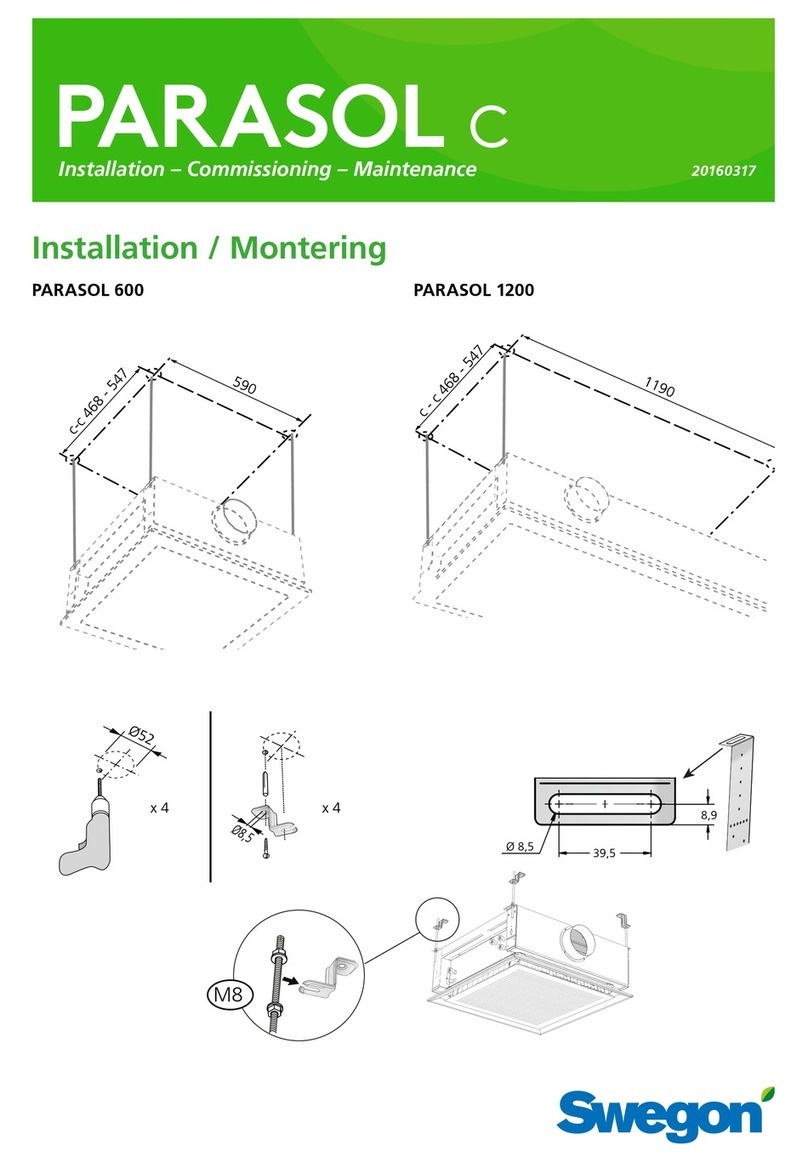
Swegon
Swegon PARASOL c Series Installation, commissioning maintenance
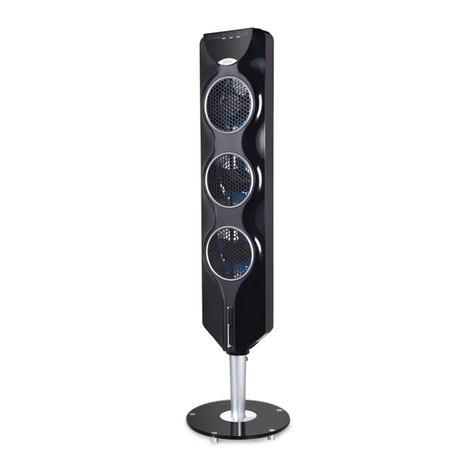
Omega Altise
Omega Altise OT1123B Operation, maintenance and safety instructions

Livoo
Livoo TEA210 instruction manual
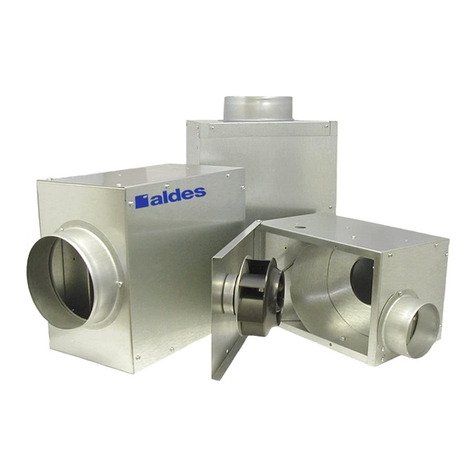
aldes
aldes VS4 MAX instructions
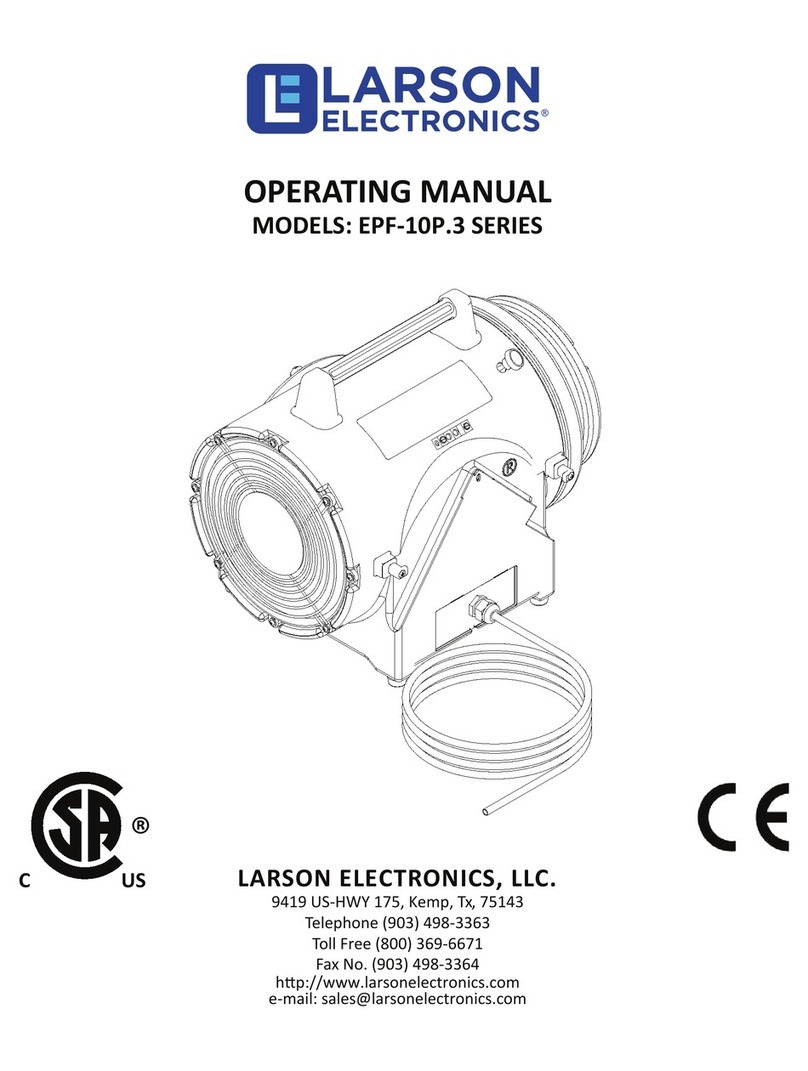
Larson Electronics
Larson Electronics EPF-10P.3 Series operating manual
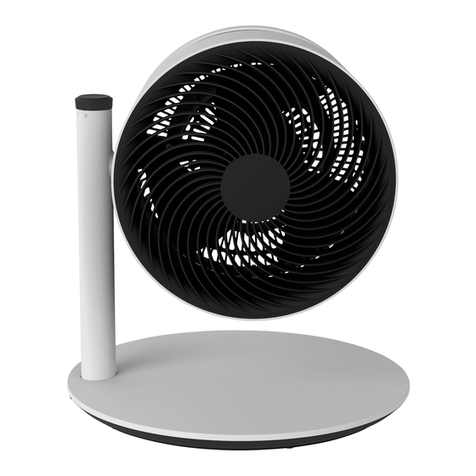
Boneco
Boneco F210 manual
